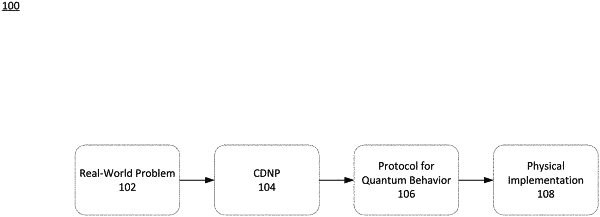| CPC G06Q 10/103 (2013.01) [G06N 7/01 (2023.01); G06N 10/00 (2019.01); G06N 10/20 (2022.01); G06Q 10/063 (2013.01); G06Q 40/04 (2013.01); H04L 9/00 (2013.01); H04L 12/00 (2013.01)] | 19 Claims |

|
1. A system for coordinating decisions, the system comprising:
a first subsystem comprising a first processor and a first memory communicatively coupled to the first processor, wherein the memory stores instructions that when executed by the first processor cause the first subsystem to perform operations comprising:
selecting a first measurement based on a first observation in a set of observations, the first measurement realizing a first set of measurement operators;
performing the first measurement on a first quantum system produced by a first quantum state source using a first detector to obtain a first measurement outcome;
executing a first action from a set of actions based on the first measurement outcome according to a quantum protocol, the quantum protocol specifying a joint quantum state shared across the first subsystem and a second subsystem, sets of measurement operators including the first set of measurement operators, the selection among the sets of measurement operators based on the set of observations, and a mapping of measurement outcomes to the set of actions, the quantum protocol based on expected utilities of the first action and a second action given the first observation and a second observation; and
wherein the first quantum state source comprises a static source or a dynamic source; and
the second subsystem comprising a second processor and a second memory communicatively coupled to the second processor, wherein the second memory stores instructions that when executed by second processor cause the second subsystem to perform operations comprising:
selecting a second measurement based on a second observation in the set of observations, the second measurement realizing a second measurement operator of the set of measurement operators;
performing the second measurement on a second quantum system produced by a second quantum state source using a second detector to obtain a second measurement outcome;
executing a second action from the set of actions based on the second measurement outcome according to the quantum protocol;
wherein the second quantum state source comprises a static source when the first quantum state source comprises a static source, and the second quantum state source comprises the first quantum state source when the first quantum state source comprises a dynamic source; and
wherein the second quantum system is entangled with the first quantum system.
|